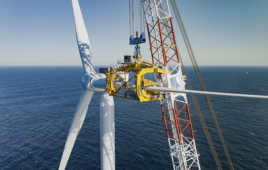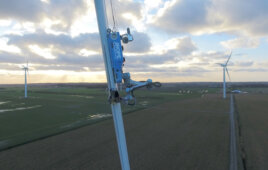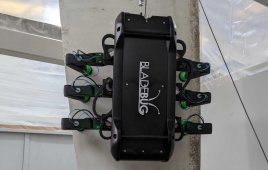Mac Larsen | Director of Application Development | Graco Inc.
Demand in the U.S. composites market is expected to grow to $10.3 billion by 2019 at a compound annual growth rate of 6.6%. Along with aerospace and automobiles, the industry can thank wind power for driving this upward trend.
High-performance composites consist of carbon, Kevlar, or glass fibers impregnated with a resin system and cured into a shape using various molding methods. They are extensively used in wind equipment, and most commonly in turbine blades. Carbon fiber is slowly gaining popularity over glass fiber for use in blades, especially as wind turbines grow in size, because of its lighter weight and greater durability. Lighter blades require less robust turbine and tower components, so the cascading cost savings justify the higher price of carbon.
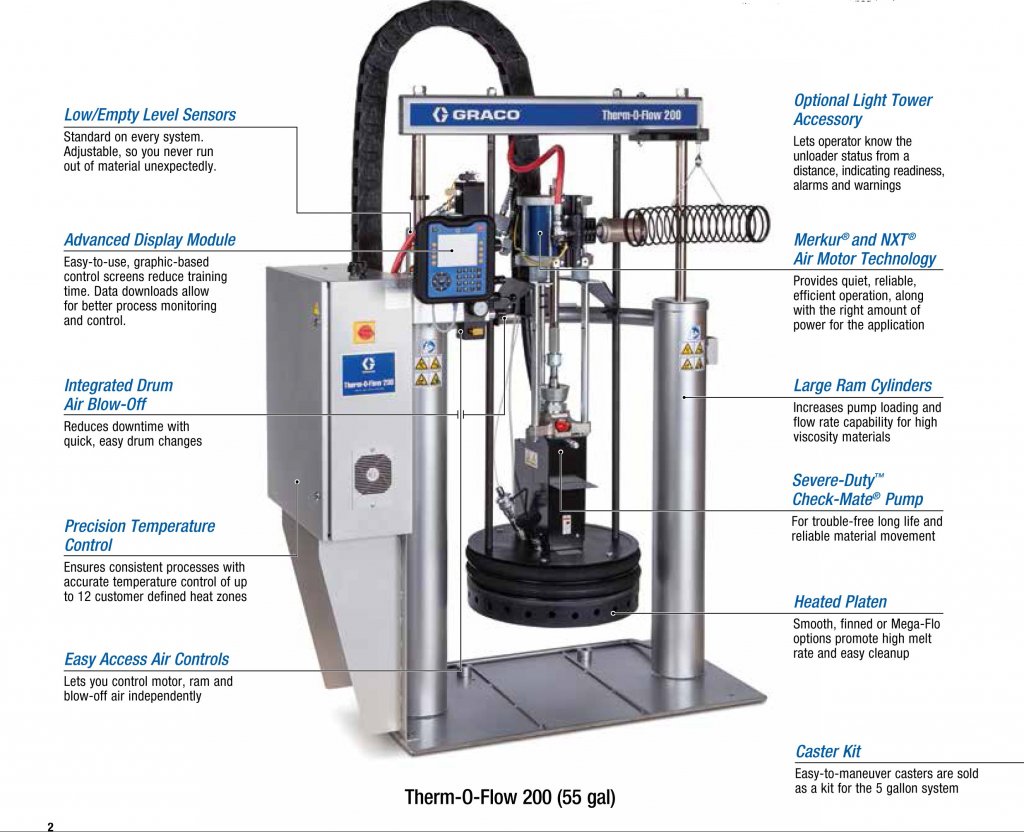
Graco’s Therm-O-Flow series of hot-melt supply machines heat and transfer only the resin that’s in close proximity with the machine’s heated platen. This leaves the rest of the drum contents at ambient temperatures, safe from advancing or aging.
One widely used resin-fiber intermediate is called “prepregs”– pre-impregnated fiber sheets formed when a thermoset heat-curable resin is combined with carbon fiber and partially cured in a continuous filming impregnation process. Prepregs are made in factory-controlled conditions to ensure that the carbon fiber-to-resin ratio is tightly managed and that the resin formulations have consistent quality.
For decades, prepregs have helped make critical composite parts for demanding applications, such as in aerospace. But as demand for high-performance composites grows, traditional prepreg processes must also keep up by transforming from basic batch operations into more efficient and higher-capacity automated processes.
Many resins used in high-performance composites have molecular make-ups that result in a thick or semi-solid product at room temperature. It’s therefore necessary to heat and mix the composites into the proper formulations before processing into prepreg intermediates. One idea to help increase capacity is to simply speed up the resin pre-heating to keep up with the higher demand of larger scale prepreg processes.
The benefits of a faster heating process include higher quality end products, improved prepreg production logistics, and reduced resin waste, which is common with lengthy heating and reheating cycles. Point-of-use resin heating is a continuous process that offers a high-volume, cost-saving alternative to traditional bulk-heating methods. Heating only what’s needed when needed is the primary goal of point-of-use resin heating, saving time and money.
The production process
The prepreg resin that’s combined with carbon fiber is a formulation of different resins, modifiers, and curatives, which are mixed together and then poured or pumped onto a filmer or coating machine by hand or with the assistance of a transfer pump. The mixed resin formulation, called a premix, can either be frozen to suspend its reactivity for filming at a later time or it can be delivered to the filming process while still hot.
As the resin mix is coated onto a base release paper, a continuous supply of dry carbon-fiber strands are pressed into the resin film, producing a prepreg. The prepreg then continues down the coating line where it’s cooled and cut into sheets or rolled up. Once the carbon fiber and resin mix cools, the resin solidifies and enters what is known as the “b-stage,” an intermediate stage where the resin is partially reacted and stable for a short period of time.
To ensure the highest quality prepreg product with the correct carbon fiber-to-resin ratio, resin premixes are created in limited volumes but multiple times daily and delivered to the prepreg filming process.
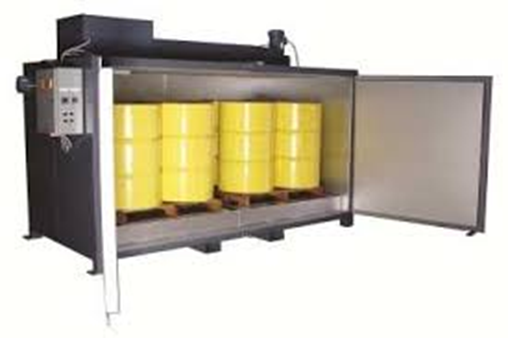
Resins are usually supplied in five-gallon or 55-gallon drums, which are heated using an oven or a clamshell drum heater for up to 48 hours. Once heated to the right consistency, the resin is then pumped into a prepreg resin batch-mixing operation for further processing.
A few problems with drum heating
Resins are usually supplied in five-gallon (20-liter) to 55-gallon (200-liter) drums. They are heated in the drum using an external heating source, such as an oven or a clamshell drum heater. The heating process can take as long as 24 to 48 hours in 55-gallon drums to ensure the viscosity is reduced enough for pumping into a prepreg resin batch-mixing operation.
Once the pre-heating process begins in the drum, higher performance multi-functional resins will advance or self-polymerize because of their autocatalytic or reactive nature. If these resins are kept hot for an extended period, they will age beyond use. Even if a 55-gallon drum of resin is heated for production but only partially used, the remaining material is likely no longer within specification and is wasted.
Precision is key during this process. The time-consuming nature of bulk heating means that production and logistics are planned in advance to ensure success. But heavy project demands often means there isn’t enough heating space to stage the drums of material required for a day’s workload. It’s easy to see that this is when point-of-use heating becomes the necessary and more cost-effective option.
The point-of-use solution
When using point-of-use drum heaters, the drums of ambient temperature resins can move from storage shelves to a platen heating system where the resin is melted and pumped “on the fly” out of the drum. This lets the remaining drum contents rest at ambient temperatures, safe from advancing or aging. Once a drum is emptied, a second or tandem platen heating system can take its place, ensuring an uninterrupted supply of hot resin to the batch-mixing process. Point-of-use heating eliminates the need for large ovens and extended heating times.
Temperature matters at every stage of production. If premix temperatures vary when added to the coating head of the filmer, coating thickness will also vary and affect the final resin-fiber ratio of a prepreg product. Viscous shear is the reason.
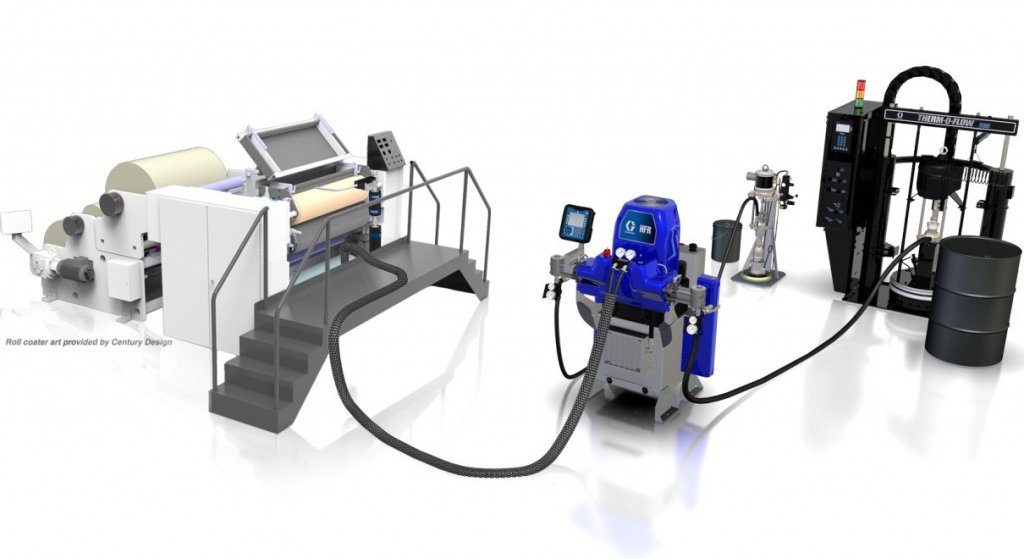
The typical inline meter-mix system is supplied by a point-of-use drum heater. The reactive hardener is metered accurately with the hot resin, and the two components are mixed inline using a static mixer, which provides a constant temperature flow of freshly mixed prepreg resin to the filmer.
Viscous shear is the friction that occurs between boundary layers (knife and roll) at a certain flow velocity (coating line speed). As the viscosity changes so does the shear, which affects the deposit of coating thickness. A tightly monitored and constant carbon-fiber feed down the line ensures a proper resin-fiber ratio. But if the resin temperature increases, the viscosity decreases and results in a reduced viscous shear through the coating slot. When shear diminishes, more resin premix can flow through the gap (under the knife), resulting in greater resin deposition on the release paper and a resin-rich prepreg.
The opposite is also true. If premix temperatures drop, viscosity increases and creates more coating head shear and reduced resin thickness. If large enough, variations in thickness lead to higher monitoring and labor costs because a technician must constantly adjust coating gaps and manage rejected prepreg materials.
Point-of-use heating pumps provide an alternative to help counter temperature and shear variation. These pumps form a constant resin premix temperature that’s delivered to the coating head, leading to a more controlled prepreg manufacturing process and ultimately higher yields. They also enable the use of inline resin metering and mixing processes.
Inline meter mix technology leverages drum-platen heating by supplying an accurate resin flow to a continuous inline mixing process and eliminates batch mixing of reactive materials. The continuous mixing process can also increase prepreg production by enabling the use of faster reacting resin systems that cure quicker. The in-line meter mix system eliminate the time-consuming cleaning process of reactive materials in expensive batch-mixing vessels.
With reduced waste and improved logistics, point-of-use resin heating offers a faster, more effective process that can easily incorporate inline mixing. As demand from various industries, including wind power, grow and as sustainability measures become integral to companies corporate mandates, point-of-use resin heating will likely become the next logical industry standard in the world of composite production.
For a digital copy of the entire August issue of Windpower Engineering & Development, click here.
Filed Under: Blades

